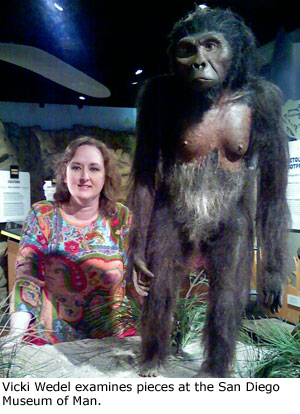

Vicki Wedel might have been an amazing doctor, except for one minor problem.”The only patients I wanted to be around were the dead ones,” she said.
That’s why she spends her time examining bones: prehistoric bones, bones from Colonial America, and even more recent - but unidentified - skeletons as she works on police cases.
“Bones tell the story of a life” she said. A bioarchaeologist and forensic anthropologist, Wedel is one of 13 new faculty members at UC Merced this fall, and the campus’s first in her field. As an undergrad, she studied biochemistry and planned to go to medical school. But near the end of her studies, she realized her passion was in studying the lives of those who have already died.
Instead of medical school, she chose a master’s in criminal justice, and worked with Oklahoma City Medical Examiner’s Office two years after the bombing of the Alfred P. Murrah Federal Building.
While working death scenes, she made another important discovery: she liked looking at bones that had been around a long time – especially the ones that hadn’t yet been identified.
She went back to school and got another master’s, this one in anthropology, worked with prehistoric remains from Arkansas, and then went onto get her Ph.D. at UC Santa Cruz, where she assisted with police cases from around the state.
Once she’s established here at UC Merced, she said, she plans to do the same work for the Valley, in addition to teaching.
“It makes for a good community service aspect for the work I do,” she said.
From her analyses, she can determine a lot, including health and nutrition, height, sex, and age at death. She can tell if the individual suffered any trauma or disease. One of her favorite projects has been working with the New York African Burial Ground Project. She examined sections of thigh bones from enslaved people from 1646-1790 in what was then the colony of New York, and compares the samples with similar sections of thigh bones from freed slaves and free born Blacks who lived in Philadelphia just before the Emancipation Proclamation (1810-1841).
She can tell that while enslaved people lived difficult lives and often died young, those who had been freed did not have significantly better health or nutritional status. They lived a bit longer, probably because they had social support networks and lived among their families, but many were still ravaged by long-term infections and iron deficiency anemia.
She and her husband, Matt, and their 2-year-old son, London, moved to Merced this summer, and she begins teaching her Intro to Biological Anthropology course on Tuesday. She’s excited to help develop the anthropology curriculum, build the school’s skeletal teaching collection, and work with faculty who are as enthusiastic about building the university as she is.
Her husband will also teach here. He loves bones, too. But the ones he likes once belonged to dinosaurs.
“I think I have the coolest job ever,” she said. “Of course, my paleontologist husband would disagree.”






